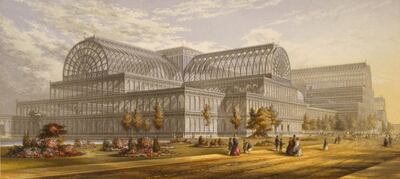There is a picture that hangs in our house in Abu Dhabi and it reminds me of many things: of growing up, family and home, in particular, but it also sends a statement about the future – more of which later.
The picture is a colour lithograph original print titled The Crystal Palace in Hyde Park for the Great Industrial Exhibition of All Nations, 1851.
To me, it is now a treasure from my childhood and a sentimental keepsake. It is a constant reminder of my late parents and the home they created. While its colours have faded over the years, its spirit is undiminished.
The memories of the day of its acquisition from a typically cluttered antiques store in London have long since melted into a semi-factual assemblage of reality.
What I do recall is that the picture was unframed but mounted on card when we came upon it, sealed in a cellophane wrapper and stacked with tens of other similar prints in boxes, ready for customers to browse through as if they were flipping through stacks of used vinyl records. We found the picture – or it found our family – as we went through those stacks and it has been in my life ever since.
I cannot tell you much about its provenance or its material value, except for the inscription at the foot of the image, which tells me that it was originally published by the 19th century engraver and publisher Archibald Alexander Park, of Leonard Street in London, and that it was almost certainly printed in 1851, when the Crystal Palace opened and hosted the exhibition from May until October.
The rest of the inscription describes a “gigantic palace, designed by Mr Paxton is magnificent in its conception and proportions … it is built entirely of glass and iron with the exception of timber for floors and joists”.
The construction of the temporary exhibition space came to represent the crowning glory of Joseph Paxton’s career as a gardener and architect.
Imperial measurements in that same footer attempt to stitch together how grand a stage the Crystal Palace was: the hall covered 18 acres of exhibition space, the structure was made from 3,230 iron columns and 2,244 girders. There were 34 miles of guttering and 900,000 feet of glass. The structure was 1,848 feet long. Every number is both meaningful and meaningless.
A pair of trees artfully frame the exterior flag-adorned exhibition space on the print. The foreground teems with finely dressed visitors. But for the fact that it is a Victorian scene rather than an Edwardian one, it is drawn as if it were a moment from Mary Poppins that you could jump into through the magic of a Disney animation.
Many similar drawings exist of the structure's exterior, all sketched from across Hyde Park. A print published by Stannard & Dixon, from seemingly the same spot, can be found in the British Museum's online collection, although that image is filled with global citizens in national dress rather than the more parochial scene of curious Victorians that I possess. Plenty more can easily be found online, suggesting there was a moment in early 1850s London when this was as popular a spot for sketch artists as, say, the grounds of the Emirates Palace hotel are today for selfie-seeking tourists.
From the past to the present: London's Crystal Palace was the venue for the first world's fair, while the latest edition is barely 300 days away from opening in Dubai. The latter's centrepiece, the Al Wasl Plaza dome, is a modern wonder of engineering with statistics to match.
As The National reported earlier this year, the 22.5 metre-wide steel crown of the structure required 18 hydraulic jacks to lift it into place. Its 550-tonne weight had to be placed on top of the dome with a margin of error of just three millimetres. I suspect Paxton would have been awed by this feat of modern engineering, if confused by the metric measurements.
He might also have recognised a common thread connecting the world fair of his day to that of today.
If the Great Exhibition highlighted "works of all nations", Expo 2020 will bring together 192 countries in a celebration of international collaboration, creativity and innovation. Six million people visited the 1851 event; more than four times that number are expected in Dubai to attend expo between October 2020 and April 2021.
The huge numbers of visitors who flocked to the 1851 event helped create a fiscal bounty big enough to fund the development of three of London’s museums. The legacy of Expo 2020 will create an entire new district of the city, Dubai South, and, it is hoped, will further stimulate this country’s non-oil knowledge economy.
I spent my childhood wondering what it would have been like to visit the Crystal Palace. The original structure was moved to south London after the end of the Great Exhibition in 1851 but burnt down in the 1930s. Next year there will be a world expo on my doorstep. I can't wait for Expo 2020 Dubai to begin.
Nick March is an assistant editor-in-chief at The National






